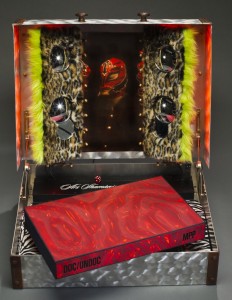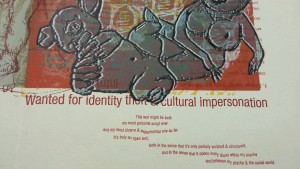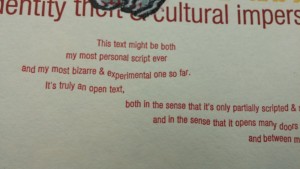Tags
accommodations, actress, art, artifact, artwork, audience, borders, Chicano, codex, conflicts, conversation, cultural, debate, dichotomy, DOC/UNDOC Documendado/Undocumented Ars Shamánica Performática, dressing room, emotions, English, essay, ethics, ethnicity, Felicia Rice, Guillermo Gomez Peña, Gustavo Vazquez, historical, identity, illegal immigration, images, immigration, interactions, interdisciplinary, interpret, interpretation, Isabel Dulfano, Jennifer González, Julia Menendez Jardon, language, lipstick, Luise Poulton, Marriott Library, Mexico, mirror, misconceptions, narcissism, opinions, paper, perceptions, performance, performer, reflection, scripts, self-identify, sound, Spanish, spectators, toolbox, United States, video, videos, viewer, visual, words, Zachary Watkins
During Fall Semester, 2015, University of Utah graduate students in SPAN6900-2 Analyzing Texts: Form and Content visited Rare Books. During the third and final session with Rare Books, the students were introduced to late 20th century/early 21st century fine press and artists’ books. The session ended with the premiere viewing of our copy of DOC/UNDOC Documentado/Undocumented Ars Shamánica Performática , purchased in September. Student response was so strong that managing curator Luise Poulton, in her typical, over-enthusiastic way, exclaimed, “You should post your thoughts on Open Book!” Prof. Isabel Dulfano, in her own enthusiastic way, immediately took up the suggestion and made this a new assignment, right then and there. Bless the beleaguered grad students! Rare Books is pleased to present these responses, one post at a time.
From Julia Menendez Jardon

DOC/UNDOC photo courtesy of Moving Press Parts
The literary work “We are here because you were there” was written by the Chicano author Guillermo Gómez-Peña. Published in 2014, it addresses a debate which is frequently heard these days in the United States: illegal immigration and whether the US should entirely close borders with Mexico. The story presents two completely opposite points of view which correspond with the two main approaches towards the topic that the US population stands for. It also brings the issue of ethnicity, and how people self-identify through language – in this case, Spanish and English.
The use of one language or another is specially relevant in this work. One of the characters speaks in English but swaps to Spanish in certain occasions, while the other character speaks only English and rejects the Spanish language. Even though the author identifies himself as a Chicano, he writes his text in English, so that the English-speaking audience can understand it without needing any extra accommodations. It is addressed to the speakers of English in the US. The author uses the first person singular when referring to the immigrant persona, and the third person singular when referring to the US resident persona. This allows Gómez-Peña to create an “othering” effect, a dichotomy that confronts the group of people who stand with the immigrants, versus the group of people who stand against them. This story doesn’t allow for shades of gray. There are only two positions: for and against. By confronting the perspectives of two parts of the US population in their native language, this socially engaged work points at the audience, urges them to reflect on a current topic, and encourages them to take a stand about it.
Although “We are here because you were there” could be approached and analyzed as an only item, it has much more to offer. This text is a performance script that belongs to a bigger work called DOC/UNDOC Documendado/Undocumented Ars Shamánica Performática. DOC/UNDOC is a combination of performance scripts by the aforementioned Gómez-Peña, their visual interpretations made by Felicia Rice, experimental videos by Gustavo Vazquez and Gómez-Peña, sound art by Zachary Watkins, and a historical and cultural essay made by Jennifer González. Each of these parts were created so that they could stand alone, but they are meant to be enjoyed together. By adding their different perspectives, these socially engaged creators made a compilation of opinions on hot topics such as ethics and decision-making, immigration, ethnicity, self-expression and self-exploration. This object carries an interdisciplinary component that is specially appealing to the audience because each of its parts were created while cognizant of the other ones’ existence.
But these are not the only interrelations that the spectators will perceive. DOC/UNDOC is heavily based on the cooperation between the audience and the artifact. From the very beginning, the instructions advise to “OPEN, EXPLORE, EMPTY, CHOOSE, REIMAGINE and COLLABORATE.”
And so we did. A little more than a week ago, my classmates and I explored this artifact thanks to our professor and two members of the Marriott library. OPEN. When we entered the room, the most noticeable part was the big metal box with the display of objects within, and the face mask that was standing on the same table.
We approached this discoverer toolbox, and I saw my reflection in the mirror. It was framed by the two vertical rows of lights and the pink fake fur that made me think I looked like an old time movie actress. I instantly thought that probably everybody else was watching me look at myself in the mirror, and I thought for a second on the degree of narcissism that being a performer must involve. I looked at myself again and I thought I was the actress. EXPLORE. The image of myself that was staring at me was trying to show different emotions. It was looking a little bit calmer than I actually was. It was looking at the sides of the box and at the pink fur, when I only wanted to look at the mirror again. I looked down at the objects and carefully examined the lipstick bar and the tin box that contained the deck of cards. I thought about the toolbox’s potential: it was a playground for grown-ups. If alone under those dressing room lights, one could adopt any identity. I was adopting a different identity already, fueled by my classmates’ ideas and assumptions. I saw my own perceptions been challenged, and I accepted. EMPTY. The image of an especially smooth piece of clay being kneaded came to my mind every now and then.
The most unsettling part of my experience began when the video started playing. I had to make a big effort to try to understand the message behind each of the clips. CHOOSE. I believed that I did not interpret the right message behind some of the videos and, after discussing with my classmates, I concluded that the important goal is to find an interpretation that convinces you as a viewer and to discuss with other watchers to keep the conversation that the creators wanted to develop.
After the videos, we walked again towards the table, and the sound clips started playing.
REIMAGINE. The characteristics of the sound reminded me of the videos I had just watched, but this time the experience was completely different. There was no image associated with it, and the visual input that I was receiving was the art that appeared in the codex. I flipped through the pages, not trying to direct my attention to any of the parts in particular. I was paying attention to the words, but also having different thoughts about each of the images I was seeing. I thought about the quality of the artwork, the thickness of the paper, and the interactions between the images and the performance scripts.
COLLABORATE. Then, we all started talking. Everybody in the room started to point at different things that they had thought about during the video, the meaning they had found to some parts of the codex, and even the possible relationships between the discoverer toolbox and the sound clips or the videos. None of us was imposing any interpretation or point of view, but we were all trying to find evidences to support each others opinions.
This is an object that targets all the five senses in multiple ways that the audience might like or might not like, but the experience will still be a remarkable one. Not only does DOC/UNDOC facilitate self-discovery and self-expression, but it also encourages the individuals to share their opinions and perceptions. In a world of conflicts and misconceptions, this piece advocates for a pause to work on each others’ understanding.
Gómez-Peña, Guillermo, et al. DOC/UNDOC: Documentado/Undocumented Ars Shamánica Performática. Santa Cruz, CA: Moving Parts Press, 2014.
Coming soon: Laura Denisse Zepeda




You must be logged in to post a comment.